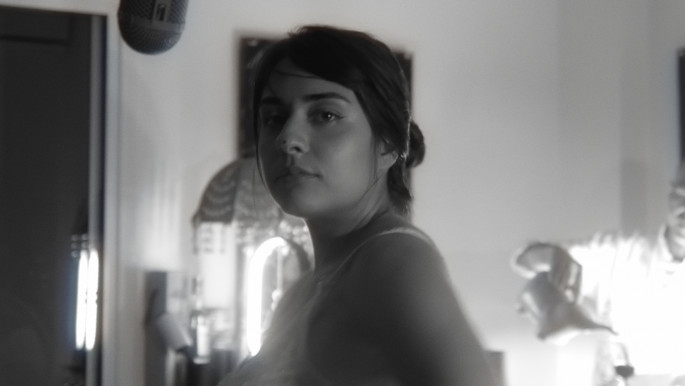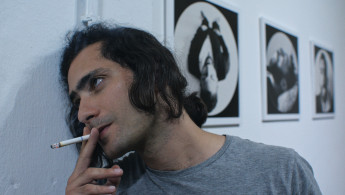Agate Mousse: Exploring the fear of mortality and the eternal cycle of life and death
In 1816 English Romantic poet John Keats wrote: "Life is but a day; A fragile dew-drop on its perilous way/From a tree's summit."
These few verses from the poem Sleep and Poetry could be an effective log line presenting the central themes of Selim Mourad's new film Agate Mousse, one of the most original titles taking part in the Tiger Competition of this year's virtual edition of the International Film Festival Rotterdam (1-7 February 2021).
The picture opens with a long list of names of extinct species recited by the Lebanese director's tranquil voice, followed by a static shot depicting him laying on a stretcher and waiting for the doctor to come.
While the practitioner visits him, Mourad breaks the fourth wall and reveals that the discovery of a deep-seated tumour in his testicle is going to force him to conclude the trilogy with this film, preceded by his two shorts Linceul (2017) and Cortex (2018).
The subsequent death of Mourad opens up an absorbing – and disorienting – self-reflexive journey on transience and decay, told through a strong visual focus on body and masculinity.
After Mourad's demise, his images mysteriously appear in an exhibition organised by a pretentious photographer and that marks the beginning of an intense "cinematic wandering," composed of painterly images, mythical references, staged sequences, philosophical commentary, circular frames and other forms of experimentation.
Moreover, in many of the scenes, Mourad's friend Tamara Saadé takes centre stage, and we see the two gradually becoming their own ancestors, and transforming themselves in symbols of the eternal cycle of birth and death.
 |
|
 |
|
| Stills from the film |
Despite its deliberately fragmentary, cryptic narration, Mourad is able to masterly dissect, with admirable aesthetic sense, the fear of mortality and the vulnerability of bodies.
A dynamic score (courtesy of Mourad's close friends Serge Yared, Jean-Baptiste Luccio and Lama Sawaya), made of several variations echoing a wide range of music genres, accompanies the narration, enhancing this highly emotional viewing experience.
Speaking about the creative process and its peculiar dramaturgy, Mourad told The New Arab: "I started sharing some ideas about the film with Tamara [Saadé] during the first half of 2018. If compared with my two shorts, this film at least had a sort of basic script, and it wasn't totally improvised.
"I had a few lines' description for each scene, but I was ready to include unpredictable events, such as the long discussion between François and Tamara at the therapist's office or the cold, restrained answers of the doctor visiting me, who is also my real dermatologist," he added.
"In general, I worked on a thin boundary between the ideas I wanted to implement and the environment I had to deal with."
 |
|
| Director Selim Mourad |
Along with the actors' freedom to improvise on set under the guidance of Mourad, post-production played a crucial role in building the film's profound philosophical meanings.
"I believe editing is the most exciting part. I worked with the same editor on the whole trilogy, Sandra Fatté. Usually, I shoot an extensive amount of footage and then we sit together in the editing room, watching it and realising what I was trying to say through those images," he told The New Arab.
Another striking feature of Mourad's work is represented by his choice to frame part of the film circularly.
"It was my own aesthetic desire. Once I was at a small exhibition in Beirut and I saw these beautiful photographs and some works impressed on zinc that were displayed in a circular form. While looking at one image after another, I experienced a sort of spiritual and artistic revelation. Maybe circularity touched me in a way that the squared shape couldn't anymore.
"Perhaps I was also influenced by the fact that circular form traditionally possessed divine qualities within the history of painting. I'm not a connoisseur, but I know that when I'm filming I need two, three elements that make me excited and circularity ended up being one of them. Besides, during the editing phase I found out that these circular frames could rotate and that was another surprising discovery," he explains.
The poetic painterly image preceding the closing credits attempts to convey – rather successfully – the essence of life and death's unstoppable cycle and is heavily influenced by Mourad's careful work on body and nudity.
The label "essay film," even though not fully embraced by the director himself, is still one that most closely describes the type of viewing experience offered by Agate Mousse.
Visually astonishing and confounding, the picture does not aim to provide answers on transience and mortality.
On the contrary, through its numerous philosophical references and suggestions, it instils Popperean doubts, inviting spectators to start their own personal path towards knowledge. Hopefully, this arthouse title will find the recognition it deserves on the international festival circuit and, later, through its distribution channels.
Davide Abbatescianni is an Italian film critic and journalist based in Cork. He works as a foreign correspondent for the EU-funded press agency Cineuropa, where he regularly writes about European cinema.
Follow him on Twitter @dabbatescianni



![sudan women [getty] sudan women [getty]](/sites/default/files/styles/image_330x185/public/media/images/5019D7F4-52AF-4377-8A05-885D27476479.jpg?h=d1cb525d&itok=tKXV7r-W)